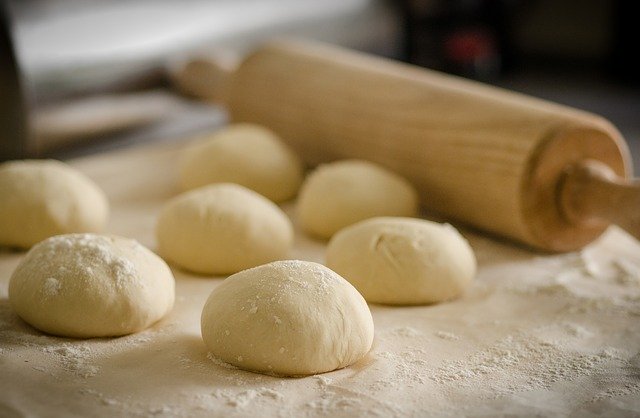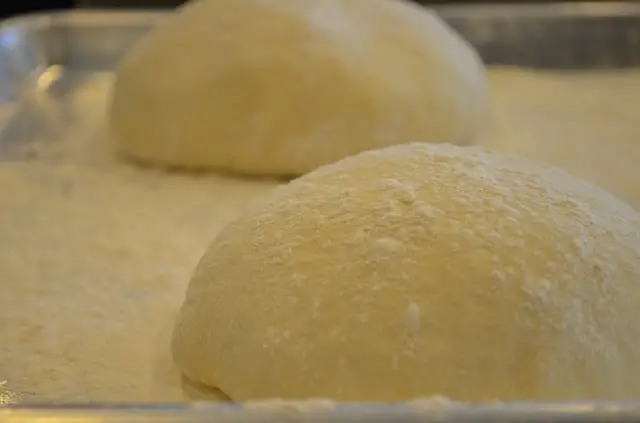If you are still learning about making pizza dough. Knowing how long to let the dough rise is a good start. Here is some expert tips on pizza crust.
Proofing pizza dough is another term used for rising dough. Also it can be called “resting” the pizza dough. These terms are used for all types of bread dough.
how long can you leave pizza dough to rise? Pizza dough can be left to rise for up to 1 hour or 3 days. Longer than 24 hours runs the risk of over proofing the dough. The amount of time is dependent on how you want to proof the pizza dough.
Rise times do depend on the recipe of the dough, it may have more yeast and sugar and will take longer. Also the times used for dough proofing varies between pizza chefs. Some say longer the better, which in most cases is true.
The good news is pizza dough can be made much quicker than 24 hours. It may not be as good, but certain store bought dough will taste just fine given a shorter rising time.
Pizza Expert Shares His Secret Dough Formula
Finding The Best Rising Time
The best rise time for flavor is usually longer, but the overall time is up to you. When do you want to make your pizza. If you plan ahead you can prep everything and allow for a slow rise.
If you want to whip up some dough for making a pizza on the same day it can be done in less than two hours.
Pizza dough rise times can vary from 1 hour up to 48 hours. The reason for such a big window is that many cooks have different methods of proofing dough. The majority of chefs seem to like a slow cool rise.
Rise times depend on two factors:
- Temperature (environment that the dough is stored in while rising).
- How the dough is made (Type of yeasts used and how much sugar).
The temperature and the dough ingredients will help you determine how long to let your pizza rise. Making dough from scratch allows you to choose between dry or fresh yeast.
Storing the pizza in a cool environment allows it rise slower. The higher the temperature the faster the pizza dough will rise.
Again letting the pizza rise for too long will start to ruin the quality of the dough. This is like doing the opposite of rising the dough, as it will start to loose its fluffy quality.
The outcome of the flavor the crust has will change as well. Yeast will consume all the sugar and being to make alcohol. This will definitely change the taste.
Use this table to help you determine what needs to be done for what time frame you choose.
| Make Pizza Tomorrow | Make Pizza Today |
| Let dough rise overnight in cool temperature. | Let dough rise for 1 – 1 1/2 hours at room temperature or in warm water. |

Best Place To Let Pizza Dough Rise
Decide how long you are going to let your pizza dough rise. The best place for rising dough slowly is in a refrigerator. The consistent temperature is perfect for a slow cool rise.
Rising dough is under two hours gives you multiple options. Most likely you will want a slightly warmer than room temperature place. Because you might want to be cooking the pizza for the evening.
Getting the dough warmed up will help to activate the yeast, then once its going just keep it above 65 degrees. Temperature plays a key part because it affects yeast the most.
Placing dough on the counter will work just fine, as long as your kitchen or house is not cold.
The best places are ones that temperature remains stable. Allowing for a even and consistent dough proofing.
Kitchen Sink: Fast Rise
- Place dough in a heavy bowl
- Cover bowl with plastic wrap
- Put bowl in the kitchen sink
- Fill sink and around the bowl with hot water
- Let dough rise for 1 – 2 hours
Oven: Faster Rise
- Preheat oven to 150 or 200 degrees
- Put dough in oven safe bowl
- Cover bowl with damp towel
- Turn off oven
- Place bowl in the oven for up to one hour (until dough has doubled in size).
Refrigerator: Slow Rise
- Place dough in a bowl
- Cover bowl with lid or plastic wrap
- Place bowl in refrigerator
- Let sit overnight
I recommend using glass mixing bowls for rising pizza dough like this brand (Amazon Link)
Instead of plastic wrap you can use a towel or paper towel. Plastic wrap (cling wrap) will seal much better, trapping in moisture.
Other options for storing rising pizza dough include: Microwave, top of refrigerator (if warmer than other spots), sunny counter top spot.
Some ovens have a warming drawer on the bottom. There will be a warming button indicating. Put dough in a bowl or container and place in drawer. Let dough rise for 1 hour.
Can You Put Dough In Fridge After It Rises?
Combination Warm and Cool
A craft way to let pizza dough rise would be to use both warm and cool temperatures. If you have the time and availability. Start out rising the dough in any warm method for about 6 – 8 hours. Then put the dough in the refrigerator for another 6 – 8 hours or overnight.
How To Know Pizza Dough Is Ready
Pizza dough can be tricky because it is a precision art to get the best desired resulting crust. The hard part is you might not know if it has been proofed properly until baking.
This is usually the case for restaurants as they want to have a unique and perfect crust. Making pizza at home, you can have a great tasting crust without needing to adjust much. You still can tweak your methods over time.
After the pizza has had time to rise, either for a day or a couple of hours. You may not be sure if it is ready.
A good indication is that the pizza dough has grown in the container. The size might not be double exactly. You don’t need to measure it to make sure the volume, weight or height has doubled.
This is where the tricky part comes into play. The carbon dioxide produced by the fermenting yeast expands the dough. So you want to let it rise just enough to expand, but not enough where the gases escape and it collapses.
So you may need to trial and error until you get the desired proofing times that work best for you. Since you will not know entirely until the dough has been baked and eaten.
Really the best way to tell is to test the texture of the pizza dough. Perform the test using your finger. You are going to poke into the dough with your finger.
Tip: The color of the dough is another giveaway that it’s ready. The color you want is yellow, not white or gray.
The hole should stay in the dough and retreat slightly. This means the dough has been proofed just enough. The rise time worked best for the temperature and recipe of the dough.
A hole that remains completely means the dough has been over-proofed. The gases has already mostly escaped and will not expand the hole you just made.
On the other side, a hole you poked that disappears mean it hasn’t risen long enough. The hole you made will retreat back and you won’t see it anymore.
| Perfect – Proof | Hole remains and starts to reform slowly but not all the way. |
| Under – Proof | Hole disappears and dough reforms. |
| Over – Proof | Hole remains completely without changing. |
How Long Can Pizza Dough Sit Out Before Cooking?
Pizza dough after it has risen should not sit out for more than a 3 hours. If you aren’t going to begin to roll out the dough right away then keep it in a refrigerator.
Even at room temperature the dough will begin to form a skin as it dries. This makes the dough harder to roll and will cook uneven. If you have no other choice try the dough or multiple dough balls in a sealed container.
How To Make Frozen Pizza Better: 8 Unique Ideas
What Happens If You Don’t Let Pizza Dough Rise?
All pizza dough will rise since it contains yeast. Even if you made the dough and skipped the proofing/rising period. The dough once being baked in the oven will rapidly start to rise. Called a oven spring, the expansion of gases and fermentation begin but will not last very long.
A pizza dough that hasn’t been proofed will be harder to work with. So it is harder to stretch and will tear easily. Rolling it out will be much easier, allowing you to make a thin crust.
Baking it cold and will lead to a heavier crust, which is tougher to chew. The fermentation brings a lot of the desired flavor to a pizza crust. This is because of certain bacteria that produces flavorful acids. A quick fermentation will not allow for these bacteria to grow.
Related Questions:
What Happens If You Over Knead Pizza Dough?
Over kneading pizza dough is not something that will happen by hand. Since it requires so much working the dough. You would have to knead the dough by hand for several hours if not days. A machine can do this quickly though.
The dough that is over kneaded will be broken down to the point where its unusable. Rather than worrying about over working the dough. Try not to use too much flour. As this will make the pizza dough stiffer.
Should I let my pizza dough rise twice?
In general letting a pizza dough rise twice will result in a lighter and more chewy crust. This helps when making thin or Neapolitan style pizza crusts. The second rise can be done at room temperature for up to one hour or refrigerated overnight. If you find your pizza crusts are tough and dense then a second rise might fix this issue.
After your first pizza dough rise once, shape your dough before the second rise. Then place the dough balls onto a plate or pan and cover with saran wrap. A container with a lid works as well. Shaping helps keep the dough rising evenly.
If you plan to make more than one crust from the pizza dough. Then divide out the dough into even pieces and then shape each one before the second rise.
Best Size Bowl for Rising Pizza Dough
A mixing bowl size of 2.5 quart or larger works really well for rising pizza dough.

